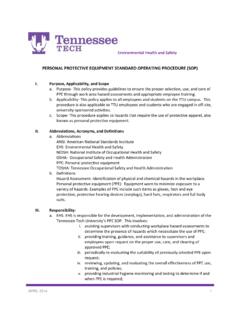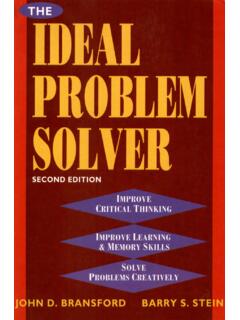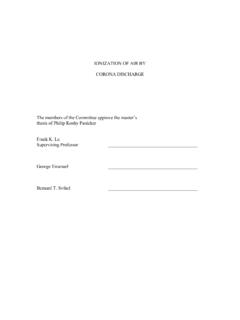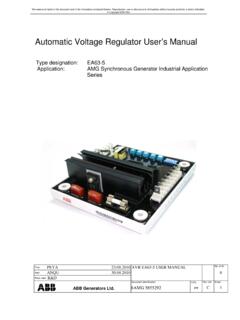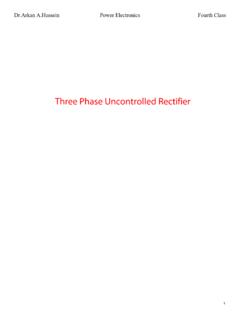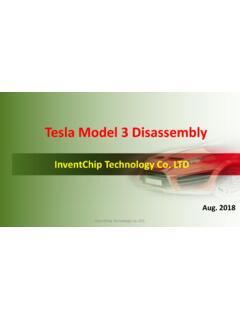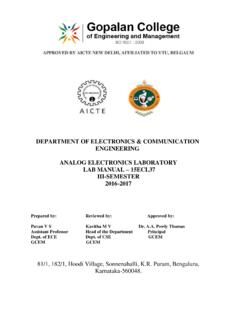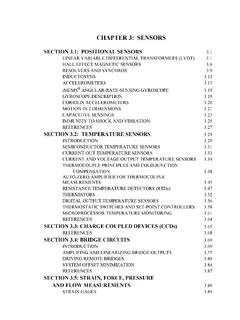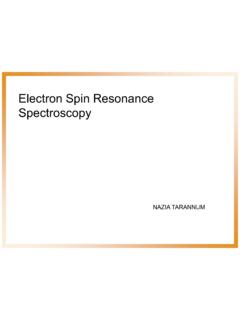Transcription of CHAPTER4 MODEL OF THREE-PHASE INVERTER
1 CHAPTER4 MODEL OF THREE-PHASE INVERTER Introduction In this chapter the THREE-PHASE INVERTER and its functional operation are discussed. In order to realize the THREE-PHASE output from a circuit employing dc as the input voltage a THREE-PHASE INVERTER has to be used. The INVERTER is build of switching devices, thus the way in which the switching takes place in the INVERTER gives the required output. In this chapter the concept of switching function and the associated switching matrix is explained. Lastly the alternatives as to how the INVERTER topologies can be formed is presented. Switching Functions It is well-known that some switching devices exist between the source and the load, the number of which depends on the circuit or the type of the load.
2 In any case the number of switching devices are limited by the complexity. Even the densest circuit has one switch between an input line and the output line. If a converter has n inputs and m outputs the number of switching devices needed for energy conversion is equal to m n . These m n switching devices in the circuit can be arranged according to their connections. The pattern suggests a matrix as shown in Figure 58linesoutputn''linesinputm''Switchesnm' ' Figure : The general switch matrix For example in realizing single phase to dc conversion the single phase has two terminals and the dc has two terminals thus a total of 2 2 = 4 switches are required. Most power electronic circuits are classified into two types [15]: 1. Direct switch matrix circuits: In these circuits any energy storage elements are connected to the matrix only at the input and output terminals.
3 The storage elements effectively become a part of the source or the load. A full wave rectifier with an output filter is an example of a direct switch matrix circuit. 2. Indirect switch matrix converters also termed as embedded converters: In these circuits, the energy storage elements are connected within the matrix structure. There are usually very few energy storage elements in such case and the indirect switch 59matrix circuits are often analyzed as cascade of two direct switch matrix circuits with storage elements in between. A switch matrix provides a clear way to organize devices for a given application. It also helps to focus the effort in to three major problems areas. Each of these areas must be addressed effectively in order to produce a useful power electronic system.
4 Hardware problem To build a switch matrix. 2. The software problem Operate the matrix to achieve the desired conversion. interface problem Add energy storage elements to provide the filters or intermediate storage necessary to meet the application requirements. These problems can more effectively be understood by considering an example of converting ac to dc, in which the hardware problem is as to how many switches have to be used which depends on whether we are performing single phase to dc conversion or three phase to dc conversion. The software problem lies in the fact that while operating these switches we need to obey the fundamentals laws of energy conversion like the Kirchhoff s voltage and the current laws and take care that these are not violated.
5 Finally as this energy conversion process is not ideal we may not get exact dc voltage at the output terminals, which require the addition of some elements before the final dc voltage is obtained. 60 Reality Of Kirchhoff s Voltage Law In determining how the switches operate in the switch matrix, care should be taken to avoid any danger in the operation of the circuit. Consider the circuit in Figure This circuit can be operated with the switch s closed owing to the fact that when the switch is closed the sum of the voltages around the loop is not equal to zero In reality a very large current will flow and this drop appears across the wires which may result in the burning of the wires that cannot take this huge voltage. Thus this circuit is not correct when the switch is closed as it violates Kirchhoff s Voltage law (KVL).
6 Thus the KVL serves as a warning that never should two unequal voltage sources be connected with out any element in between which can account for the inequality in the two voltages. AC''sacVdcV Figure : Demonstration of KVL. 61 Reality Of Kirchhoff s Current Law ACAC1I2I''s Figure : Demonstration of Kirchhoff s Current Law. As is with voltages proper care is to be taken with currents too. According to Kirchhoff s Current Law (KCL) the sum of the currents at a node should be equal to zero at all times. Thus any circuit in which KCL is not proven is dangerous to be operated as short circuit may occur. Consider the circuit in Figure , which can be operated if the switch s is opened. If it is open, that particular path is open so the current is zero and the other two current sources are unequal which violates KCL, the sum of the currents entering the node are not equal to zero.
7 The Switch State Matrix And Switching Functions Each switch in a switch matrix is either turned on or turned off . This can be represented with a mathematical matrix called the switch state matrix, which 62corresponds to the circuit. This is a matrix Q (t), with m rows and n columns, m and n depend on the number of inputs and outputs in the circuit. Each element is 1 when the corresponding switch is turned on and 0 when it is turned off . The elements of are referred to as switching functions, and are important in the design of converters. )(tqij)(tQ A general example of a switch state matrix : )(tQ m rows (m inputs) n columns (n outputs) elements = . )(tqij offisswitchifonisjilocationatswitchif,0, ,,1At a specific , the matrix will have a particular numerical value, such as ot = )(otQ.
8 The matrix might often be as small as 2 2. The software problem can be stated as choosing the switching functions a desired operation. Mathematical Representation of Switching Functions The pattern of switching for the switching devices used in converters/inverters is periodic, therefore the analysis of the switching functions is simple by using the Fourier series[14]. Let the repetition frequency of the pulses be with a time-period T; define the angular frequency ff/1=f 2=, then 63 2=Tradians. If the angular duration of the unit-value period is A/2 where A 1, then the boundaries of the unit- value period with respect to the time zero reference are A/ and A/ radians, the Fourier series for this periodic signal is given in Equation [0 Cnn ===H012//2/2/ AATTT ( ) )]sin()cos()(tnStntnn +From the standard determination of co-efficients for a Fourier expansion: )sin()sin(===tdtndttnHSn ( ) AtdHdtHTCTT12112/2/0=== ( ) nAntdtndttnHTnCAATTn/)/sin(2)cos(1)cos(2 )0(//2/2/ ===.
9 ( ) Thus )cos(]/)/[sin(21)(1tnnAnAtHnn ==+= . ( ) 64 The average value of the term, 1/A can be brought within the summation to give an alternate form of this expansion, )cos(]/)/[sin(1)(tnnAntHnn = == ( ) Equation can be written equivalently as ))/2(cos(]/)/[sin(21)(1 AktnnAnAtHnn += == . ( ) The above equation is true owing to the fact that cos()2cos()tt =. In the above expressions A can be an integer, rational or an irrational number. When A is an integer multiple of A then the term sin()/An vanishes. In Equation all those terms in which n is an integer multiple of A vanish, and so it reduces to a fundamental component and a time varying term.
10 Thus the switching pulses can be represented as a dc component and a cos or sine varying term as in Equation , )1(21M+=S ( ) where M is called the modulation signal, which can be any sine or cos term (in accordance to Fourier series) depending on the control we want to implement. The more general fundamental component for M is given as )cos( =tmMa ( ) in the above expression is called the modulation index which can vary from 0 to 1 and for values of less than 1 a linear modulation range is supposed to exist and for values of greater than 1 it is operated in the over modulation range. amamam 65 THREE-PHASE INVERTER The dc to ac converters more commonly known as inverters, depending on the type of the supply source and the related topology of the power circuit, are classified as voltage source inverters (VSIs) and current source inverters (CSIs).

